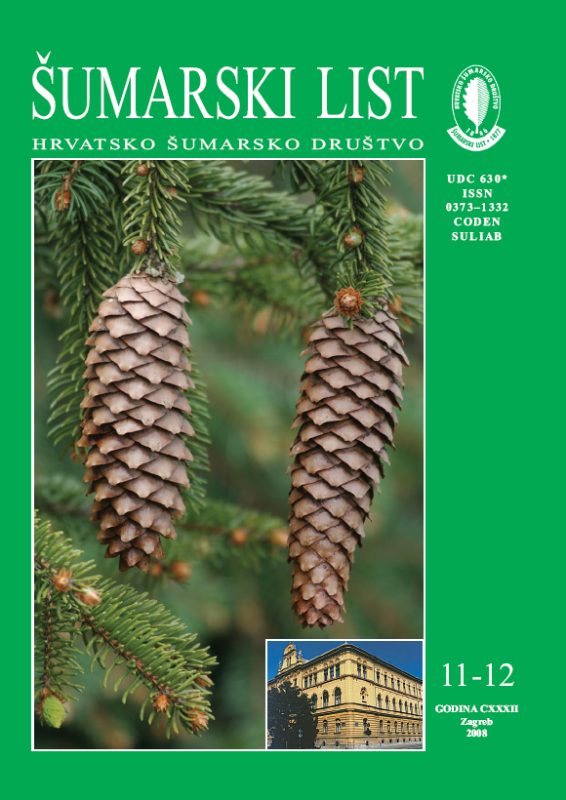
broj: 11-12/2008
pdf (7,1 MB) |
|
||||||||||||||
| RIJEČ GLAVNOGA UREDNIKA | ||
| Branimir Prpić | ||
| AT THE END OF THE YEAR PDF HR EN | 504 | |
| IZVORNI ZNANSTVENI ČLANCI | ||
| Anić, I., S. Mikac | UDK 630* 907 : 569 + 221 + 231 (001) | |
| Structure, Texture and Regeneration of Dinaric Beech-fir Virgin forest of Čorkova Uvala pdf HR EN | 505 | |
| Matošević, D. M. Pernek, M. Županić | UDK 630* 453 (001) | |
| Leafminers as Pests on Oaks (Quercus Spp.) in Croatia pdf HR EN | 517 | |
| Ivanković, M., S. Bogdan, G. Božič | UDK 630* 561 Fagus sylvatica L. (001) | |
| European Beech (Fagus sylvatica L.) Height Growth Variability in Croatian and Slovenian Provenance Trials pdf HR EN | 529 | |
| Summary: We present an overview of the first results on height growth variability of the European beech (Fagus sylvatica L.) provenances in Croatian and Slovenian field tests. The field tests (one in each country) were established in the spring of 1998 with 2 years old plants. 36 provenances were planted in the Croatian trial and 38 provenances in the Slovenian one, in a randomised complete block design (RBD) in three replications with 150 seedlings per provenance. The Croatian trial includes provenances from 13 European countries (Austria, Belgium, Croatia, Czech Republic, Denmark, France, Great Britain, Germany, Netherlands, Poland, Slovenia, Sweden, and Ukraine) while Slovenian trial includes provenance from 15 European countries (Austria, Belgium, Czech Republic, Denmark, France, Germany, Great Britain, Italy, Luxemburg, Netherlands, Poland, Slovakia, Slovenia, Sweden, Switzerland). The first results relate to the survival rate and heights in autumn 2005, at the plant age of 8 years. The Slovenian trial had a better survival rate and a larger average height. The P-13 provenance (Soignes – B) had the best survival rate of 94,0% (in Slovenian trial); the largest heights in Slovenian trial were recorded also for the local Slovenian provenance P-53 ( 242,80 cm, Postojna – Masun); Provenance testing on two different sites showed that some provenances (P-05 Bretagne F, P-31 Urach D, P-17 Westfield GB) exhibited a general adaptedness and phenotypic stability, while other provenances were phenotypically instable, i.e. exhibited specific adaptedness (P-64 Nizbor, CZ, P-51 Horni Plana-Ce CZ). Anova showed that provenances were statistically significant effect only in the Slovenian trial, while in the Croatian one as well as in combined analysis there were no between provenance differences. Block by provenance interactions were statistically significant in both trials, indicating strong micro site influences. However, blocks were not properly conducted in Croatian trial because they were perpendicular to slope, probably causing strong provenance by block interaction. Moreover, in Slovenian trial number of studied provenances was not the same, which was also cause for strong interaction effect. Our believe is that due to above mentioned reasons, provenance by block interactions in both trials were overestimated and consequently that was the reason for underestimating provenance effect. Tukey-Kramer test did not show clinal geographic pattern of between provenance differences, so it can be concluded that results indicate ecotypic genetic differentiation of studied provenances. However, future studies which should include ecological variables of mother stands might put more light on the pattern of genetic variation. These results shall be evaluated in the future for possible use in breeding and conservation of the European beech genetic resources. Key words: ecotypes; genetic variation; quantitative traits | ||
| STRUČNI ČLANCI | ||
| Frković, Alojzije | UDK 630* 156 | |
| Reintroduction of Chamois in Northern Velebit pdf HR EN | 543 | |
| Meštrić, Branko | UDK 630* 945 | |
| Digitization of Journal of Forestry pdf HR EN | 551 | |
| Domac, J., Z. Benković, T. Starčić | UDK 630* 867 | |
| Development of a sustainable charcoal industry pdf HR EN | 555 | |


